Abstract
Sterile parotid saliva inhibited growth of Legionella pneumophila on solid media, and the salivary component involved in this inhibition has been shown to be amylase. Disk diffusion and well plate assays were used to study possible mechanisms for this effect. The amylolytic activity of saliva copurified with inhibitory activity, and both activities were sensitive to proteinase K digestion and heat treatment. In addition, purified alpha-amylase from several sources (bacteria, fungi, porcine pancreas, and human saliva) exhibited similar activity. Incorporation of charcoal or bovine serum albumin into media blocked inhibition by amylase. Replacement of Bacto-Agar with Noble agar (both from Difco Laboratories) prevented growth inhibition in the absence of starch. However, when corn starch was present with Noble agar, amylase-induced growth inhibition occurred. Purification of starch by washing with methanol eliminated some toxic component. The toxic component from starch could be recovered from the methanol wash and inhibited growth of L. pneumophila in the absence of amylase activity. The results suggest that toxic substances exist in media components which may be unmasked during salivary amylase digestion of starch. This effect may explain, in part, the difficulty in recovery of the organism from clinical specimens containing amylase.
Full text
PDF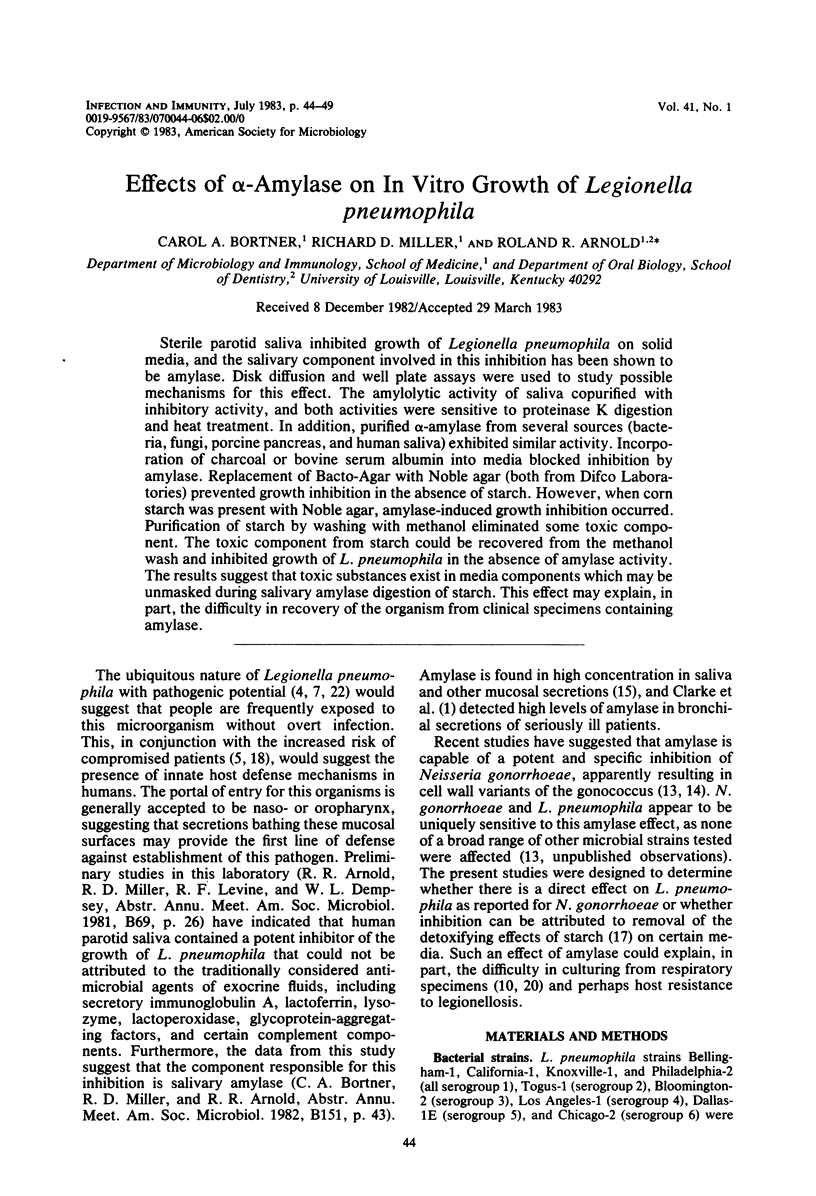
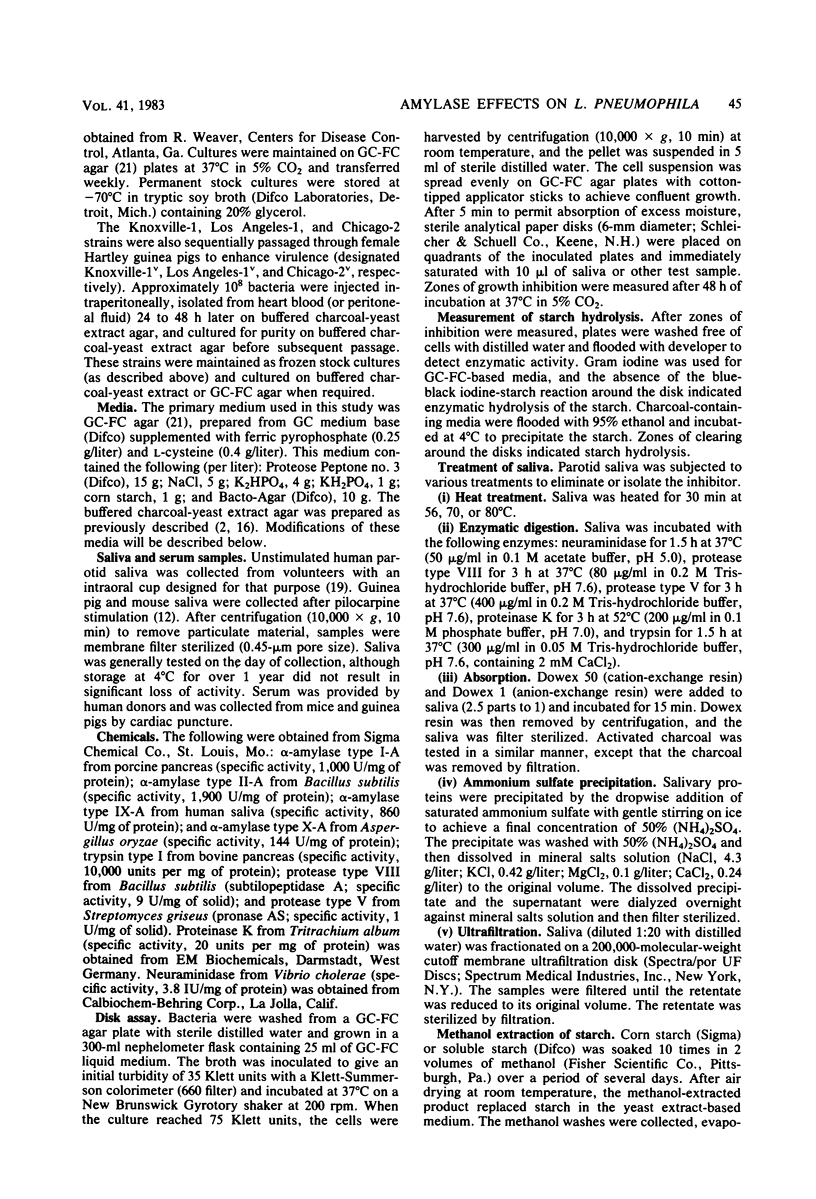
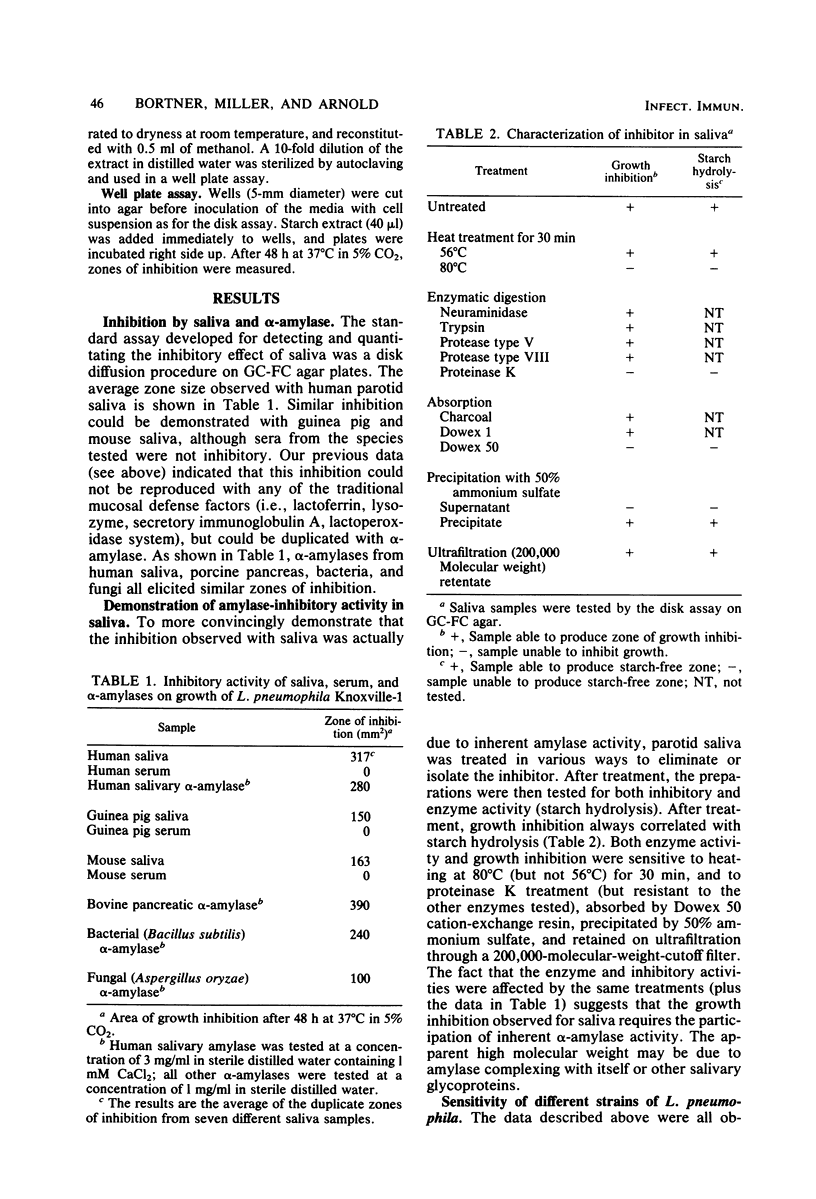
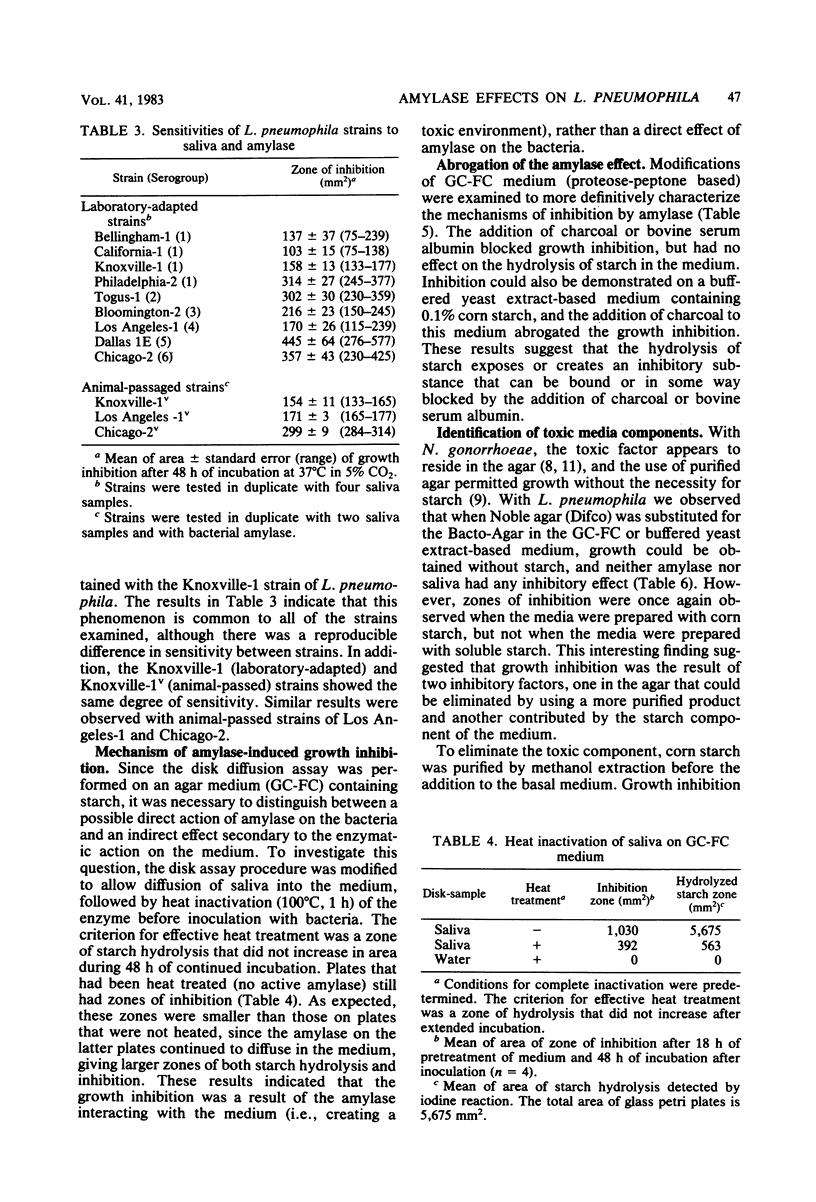
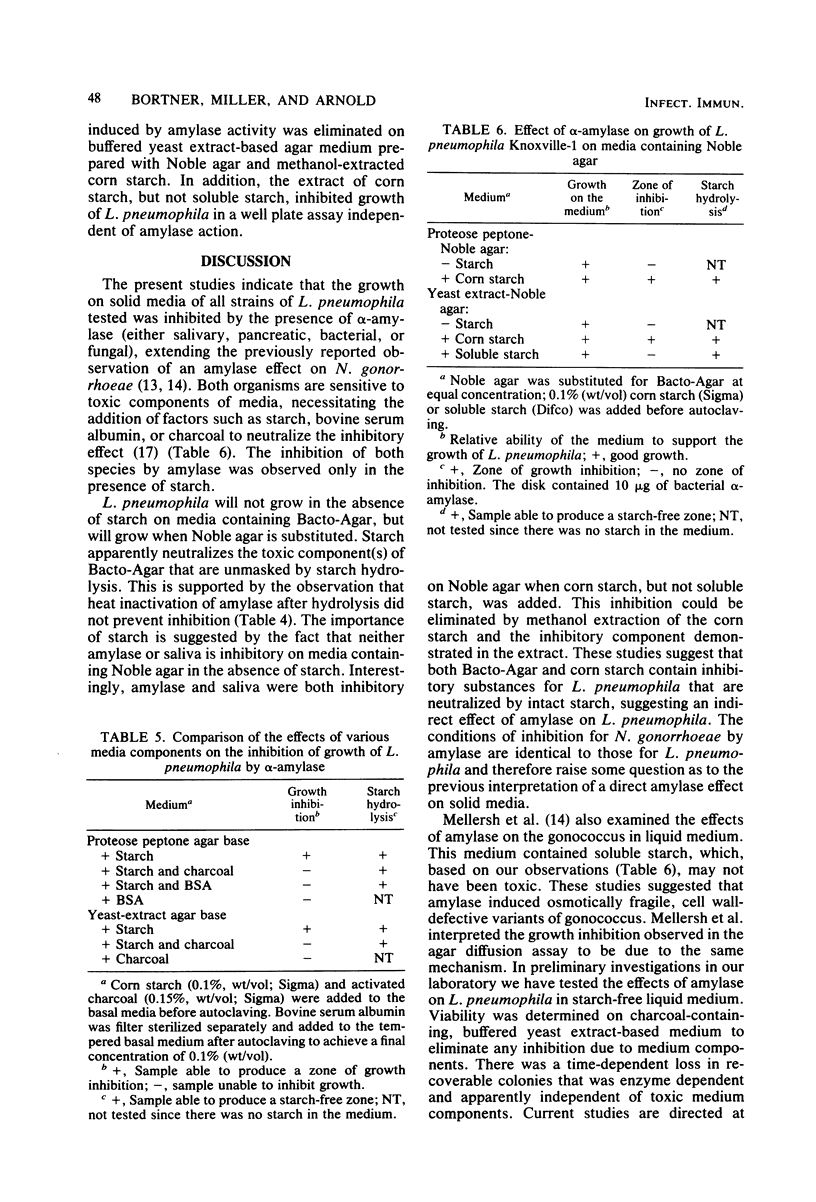
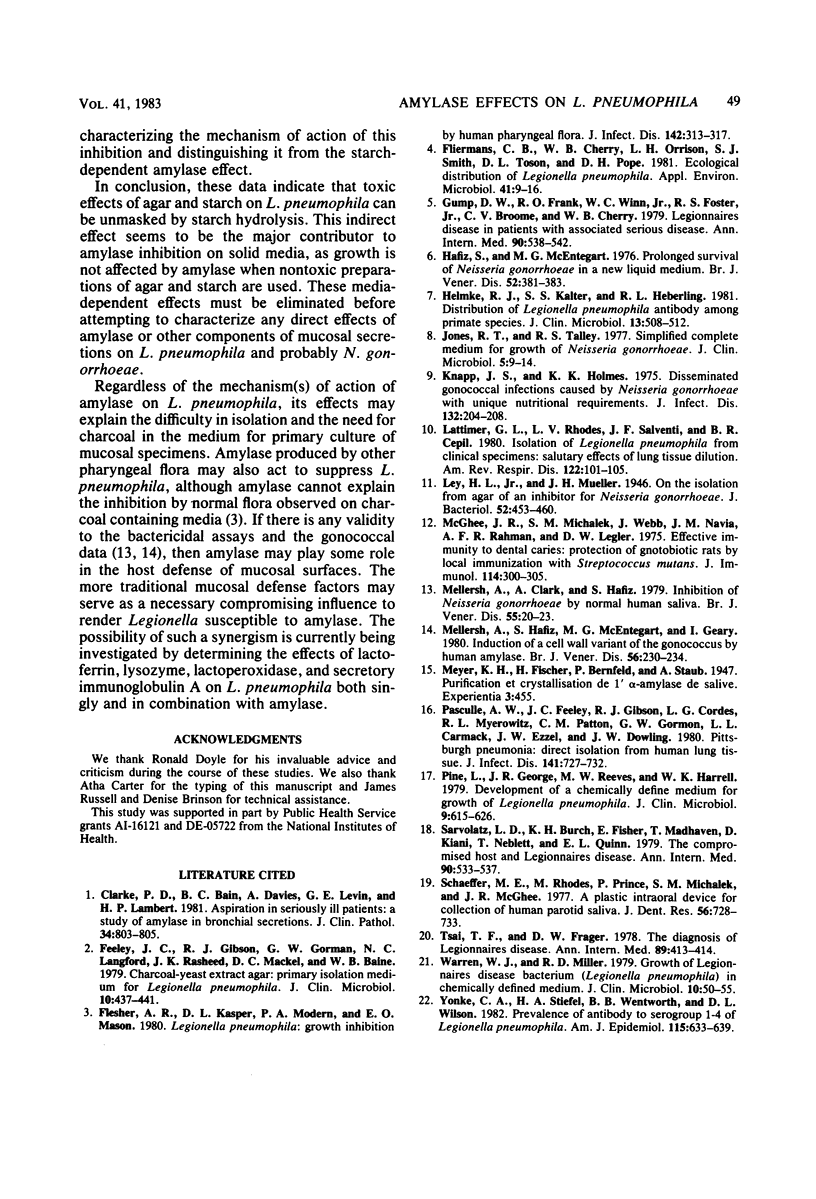
Selected References
These references are in PubMed. This may not be the complete list of references from this article.
- Clarke P. D., Bain B. C., Davies A., Levin G. E., Lambert H. P. Aspiration in seriously ill patients: a study of amylase in bronchial secretions. J Clin Pathol. 1981 Jul;34(7):803–805. doi: 10.1136/jcp.34.7.803. [DOI] [PMC free article] [PubMed] [Google Scholar]
- Feeley J. C., Gibson R. J., Gorman G. W., Langford N. C., Rasheed J. K., Mackel D. C., Baine W. B. Charcoal-yeast extract agar: primary isolation medium for Legionella pneumophila. J Clin Microbiol. 1979 Oct;10(4):437–441. doi: 10.1128/jcm.10.4.437-441.1979. [DOI] [PMC free article] [PubMed] [Google Scholar]
- Flesher A. R., Kasper D. L., Modern P. A., Mason E. O., Jr Legionella pneumophila: growth inhibition by human pharyngeal flora. J Infect Dis. 1980 Sep;142(3):313–317. doi: 10.1093/infdis/142.3.313. [DOI] [PubMed] [Google Scholar]
- Fliermans C. B., Cherry W. B., Orrison L. H., Smith S. J., Tison D. L., Pope D. H. Ecological distribution of Legionella pneumophila. Appl Environ Microbiol. 1981 Jan;41(1):9–16. doi: 10.1128/aem.41.1.9-16.1981. [DOI] [PMC free article] [PubMed] [Google Scholar]
- Gump D. W., Frank R. O., Winn W. C., Jr, Foster R. S., Jr, Broome C. V., Cherry W. B. Legionnaires' disease in patients with associated serious disease. Ann Intern Med. 1979 Apr;90(4):538–542. doi: 10.7326/0003-4819-90-4-538. [DOI] [PubMed] [Google Scholar]
- Hafiz S., McEntegart M. G. Prolonged survival of Neisseria gonorrhoeae in a new liquid medium. Br J Vener Dis. 1976 Dec;52(6):381–383. doi: 10.1136/sti.52.6.381. [DOI] [PMC free article] [PubMed] [Google Scholar]
- Helmke R. J., Kalter S. S., Heberling R. L. Distribution of Legionella pneumophilia antibody among primate species. J Clin Microbiol. 1981 Mar;13(3):508–512. doi: 10.1128/jcm.13.3.508-512.1981. [DOI] [PMC free article] [PubMed] [Google Scholar]
- Jones R. T., Talley R. S. Simplified complete medium for the growth of Neisseria gonorrhoeae. J Clin Microbiol. 1977 Jan;5(1):9–14. doi: 10.1128/jcm.5.1.9-14.1977. [DOI] [PMC free article] [PubMed] [Google Scholar]
- Knapp J. S., Holmes K. K. Disseminated gonococcal infections caused by Neisseria gonorrhoeae with unique nutritional requirements. J Infect Dis. 1975 Aug;132(2):204–208. doi: 10.1093/infdis/132.2.204. [DOI] [PubMed] [Google Scholar]
- Lattimer G. L., Rhodes L. V., 3rd, Salventi J. F., Cepil B. R. Isolation of Legionella pneumophila from clinical specimens: salutary effects of lung tissue dilution. Am Rev Respir Dis. 1980 Jul;122(1):101–105. doi: 10.1164/arrd.1980.122.1.101. [DOI] [PubMed] [Google Scholar]
- Ley H. L., Jr, Mueller J. H. On the Isolation from Agar of an Inhibitor for Neisseria gonorrhoeae. J Bacteriol. 1946 Oct;52(4):453–460. doi: 10.1128/jb.52.4.453-460.1946. [DOI] [PMC free article] [PubMed] [Google Scholar]
- McGhee, Michalek S. M., Webb J., Navia J. M., Rahman A. F., Legler D. W. Effective immunity to dental caries: protection of gnotobiotic rats by local immunization with Streptococcus mutans. J Immunol. 1975 Jan;114(1 Pt 2):300–305. [PubMed] [Google Scholar]
- Mellersh A., Clark A., Hafiz S. Inhibition of Neisseria gonorrhoeae by normal human saliva. Br J Vener Dis. 1979 Feb;55(1):20–23. doi: 10.1136/sti.55.1.20. [DOI] [PMC free article] [PubMed] [Google Scholar]
- Mellersh A., Hafiz S., McEntegart M. G., Geary I. Induction of a cell wall variant of the gonococcus by human amylase. Br J Vener Dis. 1980 Aug;56(4):230–234. doi: 10.1136/sti.56.4.230. [DOI] [PMC free article] [PubMed] [Google Scholar]
- Pasculle A. W., Feeley J. C., Gibson R. J., Cordes L. G., Myerowitz R. L., Patton C. M., Gorman G. W., Carmack C. L., Ezzell J. W., Dowling J. N. Pittsburgh pneumonia agent: direct isolation from human lung tissue. J Infect Dis. 1980 Jun;141(6):727–732. doi: 10.1093/infdis/141.6.727. [DOI] [PubMed] [Google Scholar]
- Pine L., George J. R., Reeves M. W., Harrell W. K. Development of a chemically defined liquid medium for growth of Legionella pneumophila. J Clin Microbiol. 1979 May;9(5):615–626. doi: 10.1128/jcm.9.5.615-626.1979. [DOI] [PMC free article] [PubMed] [Google Scholar]
- Saravolatz L. D., Burch K. H., Fisher E., Madhavan T., Kiani D., Neblett T., Quinn E. L. The compromised host and Legionnaires' disease. Ann Intern Med. 1979 Apr;90(4):533–537. doi: 10.7326/0003-4819-90-4-533. [DOI] [PubMed] [Google Scholar]
- Schaeffer M. E., Rhodes M., Prince S., Michalek S. M., McGhee J. R. A plastic intraoral device for the collection of human parotid saliva. J Dent Res. 1977 Jul;56(7):728–733. doi: 10.1177/00220345770560070401. [DOI] [PubMed] [Google Scholar]
- Tsai T. F., Fraser D. W. The diagnosis of Legionnaires' disease. Ann Intern Med. 1978 Sep;89(3):413–414. doi: 10.7326/0003-4819-89-3-413. [DOI] [PubMed] [Google Scholar]
- Warren W. J., Miller R. D. Growth of Legionnaires disease bacterium (Legionella pneumophila) in chemically defined medium. J Clin Microbiol. 1979 Jul;10(1):50–55. doi: 10.1128/jcm.10.1.50-55.1979. [DOI] [PMC free article] [PubMed] [Google Scholar]
- Yonke C. A., Stiefel H. E., Wentworth B. B., Wilson D. L. Prevalence of antibody to serogroups 1-4 of Legionella pneumophila: a seroepidemiologic study using the indirect hemagglutination test. Am J Epidemiol. 1982 May;115(5):633–639. doi: 10.1093/oxfordjournals.aje.a113345. [DOI] [PubMed] [Google Scholar]


